MARIANI’S
Virtual
Gourmet
August 27, 2017
NEWSLETTER
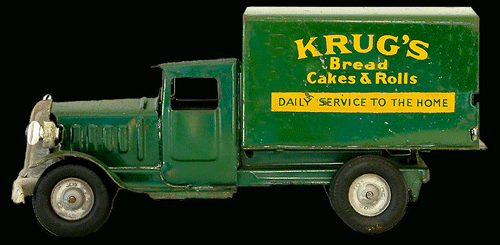
❖❖❖
IN THIS ISSUE
DINING WELL AT WALT DISNEY
WORLD RESORT
Part One
By John Mariani
NEW YORK CORNER
RAHI
By John Mariani
NOTES FROM THE WINE CELLAR
CHABLIS
By Geoff Kalish
❖❖❖
DINING WELL
AT WALT DISNEY WORLD RESORT
Part One
By John Mariani
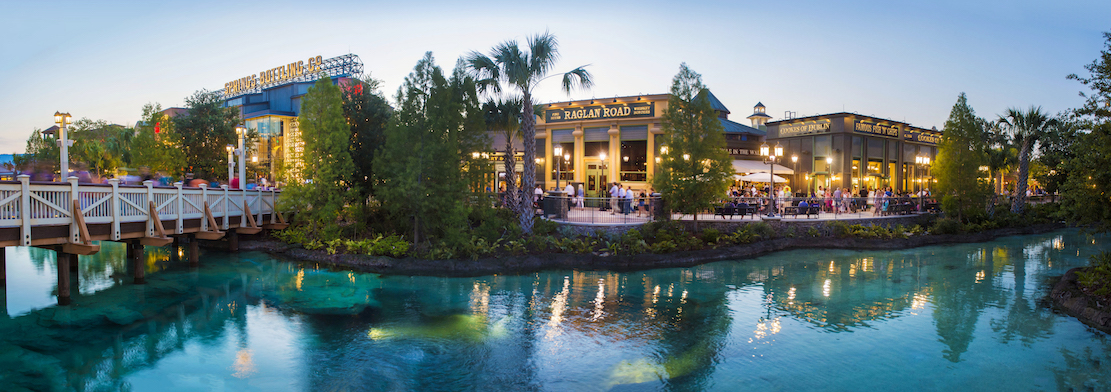
Believe it or
not, I actually visited Disneyland in Anaheim,
California (below),
in its first year of opening, 1955, and as a
wide-eyed ten-year-old, I put great food way
down my list of interests. Not when there were
so many 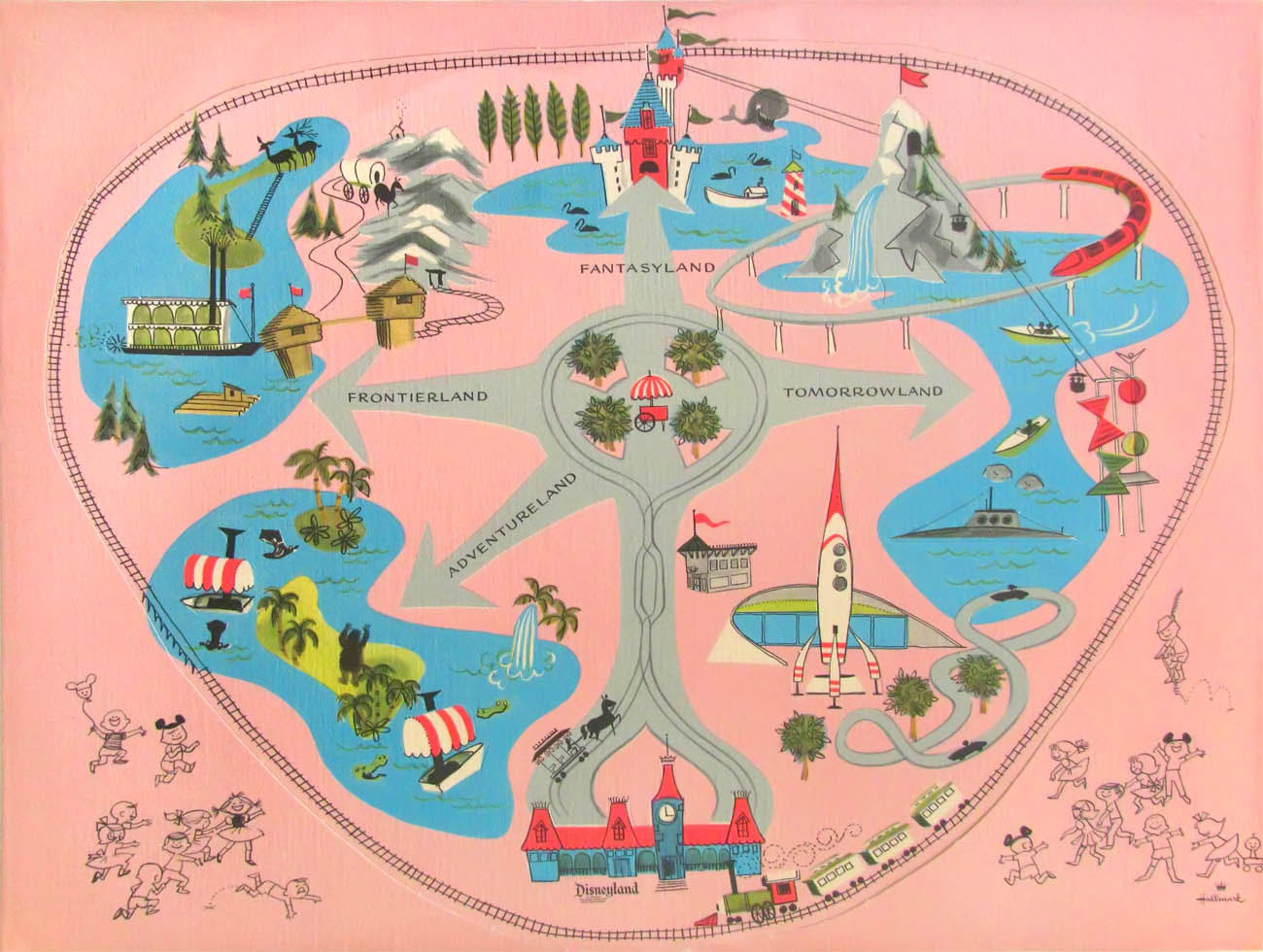 other attractions,
from a Jungle Cruise to a rocket ship
take-off, spinning Mad Hatter teacups and cool
race cars to putter around in.
other attractions,
from a Jungle Cruise to a rocket ship
take-off, spinning Mad Hatter teacups and cool
race cars to putter around in.
Yet I still remember the
fried chicken and honey biscuits served at the
Carnation Ice Cream Parlor off Main Street as a
delectable alternative to the burger-and-hot dog
fare found all over the park. It really wasn’t
until the opening of Walt Disney World in Lake
Buena Vista, Florida, in 1971, that the
entertainment giant started paying serious
attention to food. Then, with the opening of the
new international pavilions at EPCOT Centre (below)
in 1982, they really upped the quality and
diversity of food—even wine—by contracting
established restaurateurs and chefs to open
places like Chefs de France, Alfredo the
Original of Rome, Nine Dragons and more, with
themed restaurants like The Hollywood Brown
Derby at Disney-MGM Studios (now Disney’s
Hollywood Studios) and some highly innovative
restaurants in the hotels and resorts like the
California Grill at Disney's Contemporary
Resort and Victoria and Albert's at
Disney's Grand Floridian Resort & Spa. The
latter were very, very good; the former EPCOT
restaurants better than previous efforts.
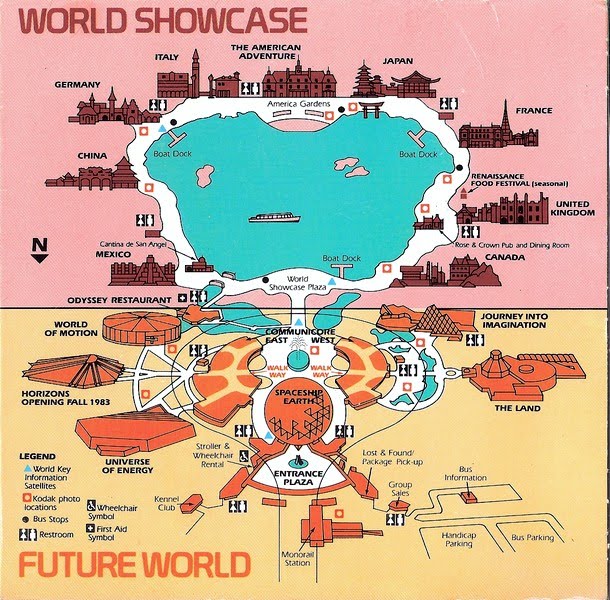 When my
two sons were little boys I returned to Disney
World several times and watched the evolution of
the dining segment throughout the vast resort,
not least at the annual Wine and Food Festival,
which has grown (and is still growing) into one
of America’s largest and most respected events
of its kind. To be sure, fast food and family
restaurants still dominate the landscape, but
Disney’s clientele is far more upscale than it
was in 1955, and every year older restaurants
have been retired or re-concepted and new
restaurants opened as whole park attractions are
added, like the new Pandora--The World of Avatar,
which has a vast Satu’li Canteen built to look
like a Quonset hut mess hall and serving dishes
like chili-spiced crispy fried tofu bowl and a
Sustainable Fish Bowl.
When my
two sons were little boys I returned to Disney
World several times and watched the evolution of
the dining segment throughout the vast resort,
not least at the annual Wine and Food Festival,
which has grown (and is still growing) into one
of America’s largest and most respected events
of its kind. To be sure, fast food and family
restaurants still dominate the landscape, but
Disney’s clientele is far more upscale than it
was in 1955, and every year older restaurants
have been retired or re-concepted and new
restaurants opened as whole park attractions are
added, like the new Pandora--The World of Avatar,
which has a vast Satu’li Canteen built to look
like a Quonset hut mess hall and serving dishes
like chili-spiced crispy fried tofu bowl and a
Sustainable Fish Bowl.
Disney Springs has expanded
to include a plethora of new eateries—52 of
them—from Aristocrepes
and a series of food trucks to a House of Blues
and Raglan
Road Irish Pub. When I visited this
year I had lunch at the two-year-old BOATHOUSE,
which is situated, as you’d expect, on the docks
and configured like the kind of seafood
restaurant yachtsmen and casual boaters alike
would hang out in and 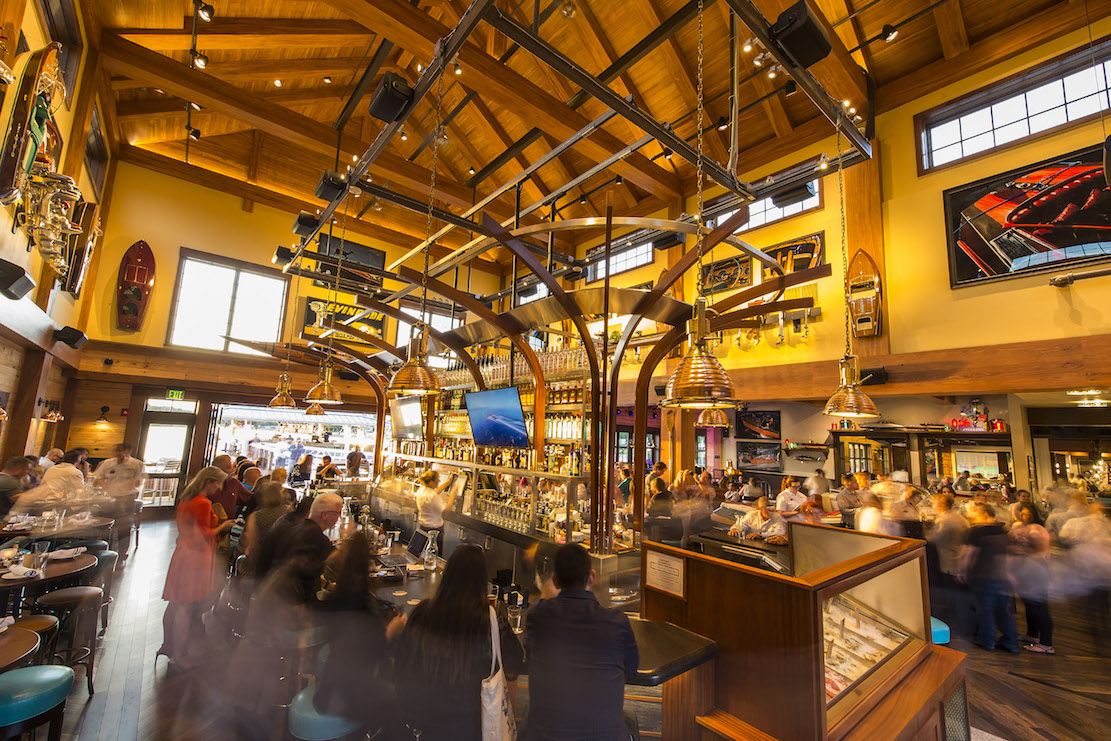 celebrate during the
America’s Cup races. You can get there in a
1950s Amphicar, and there’s a sleek (immobile)
speedboat in the middle of the dining room. I
dined at a handsome white and green semi-open
room overlooking the water, which looked like it
would fit into the classiest beach club in Palo
Alto.
celebrate during the
America’s Cup races. You can get there in a
1950s Amphicar, and there’s a sleek (immobile)
speedboat in the middle of the dining room. I
dined at a handsome white and green semi-open
room overlooking the water, which looked like it
would fit into the classiest beach club in Palo
Alto.
The Boathouse is run by
Chicago’s Gibson Restaurant Group, whose
portfolio has always included first-rate seafood
menus, and this is their best effort in that
genre to date. With several people at my table I
sampled a great deal, from “large” Florida stone
crabs (priced by the pound) that were closer to
“jumbo” or “colossal” in size, and a Maine-style
lobster bisque ($8 or $12) that tasted intensely
of sweet lobster, not tomato or cream.
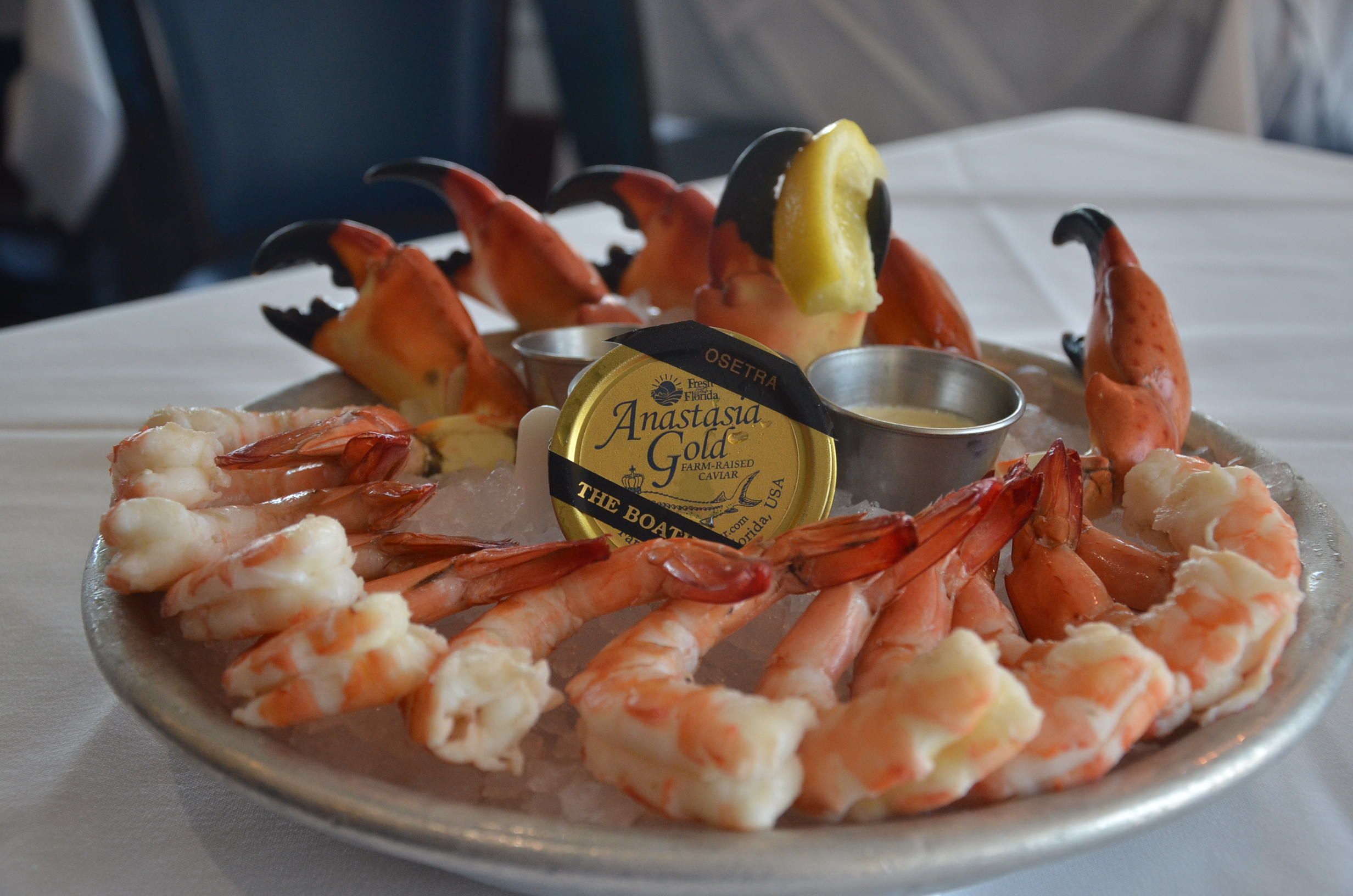 Frying
seafood well is not as easy as dunking it in hot
oil, but at The Boathouse the panko-dusted cod
($18) was as crisp as it could be, with the
white fish beneath steaming hot and juicy. A
thick slab of swordfish ($31) was broiled with
the same attention to detail, served with a
butternut puree, roasted Fuji apples, fingerling
potatoes, petite peppers and pearl onions in a
rich garlic butter. I applauded the abundance of
succulent meat in the New England lobster roll
($29.95), but that day the roll itself was dried
out. Soft shell crab, a tad small in size, came
with a peach salad, aromatic Old Bay seasoned
remoulade and the crunch of pecan-smoked bacon.
Frying
seafood well is not as easy as dunking it in hot
oil, but at The Boathouse the panko-dusted cod
($18) was as crisp as it could be, with the
white fish beneath steaming hot and juicy. A
thick slab of swordfish ($31) was broiled with
the same attention to detail, served with a
butternut puree, roasted Fuji apples, fingerling
potatoes, petite peppers and pearl onions in a
rich garlic butter. I applauded the abundance of
succulent meat in the New England lobster roll
($29.95), but that day the roll itself was dried
out. Soft shell crab, a tad small in size, came
with a peach salad, aromatic Old Bay seasoned
remoulade and the crunch of pecan-smoked bacon.
For dessert, you won’t find
better Key lime pie or strawberry shortcake in
the entire resort.
This being Disney, there are
sandwiches and children’s menus offered, and a
whole section of steaks and chops. Except for a
few Champagnes, the wine list at The Boathouse
is all American, about equally white and red,
with plenty of bottlings under $50 in both
categories. Mark-ups are overall quite
reasonable—mostly about 100% above retail. The
bar has a dozen specialty cocktails and about
two dozen beers.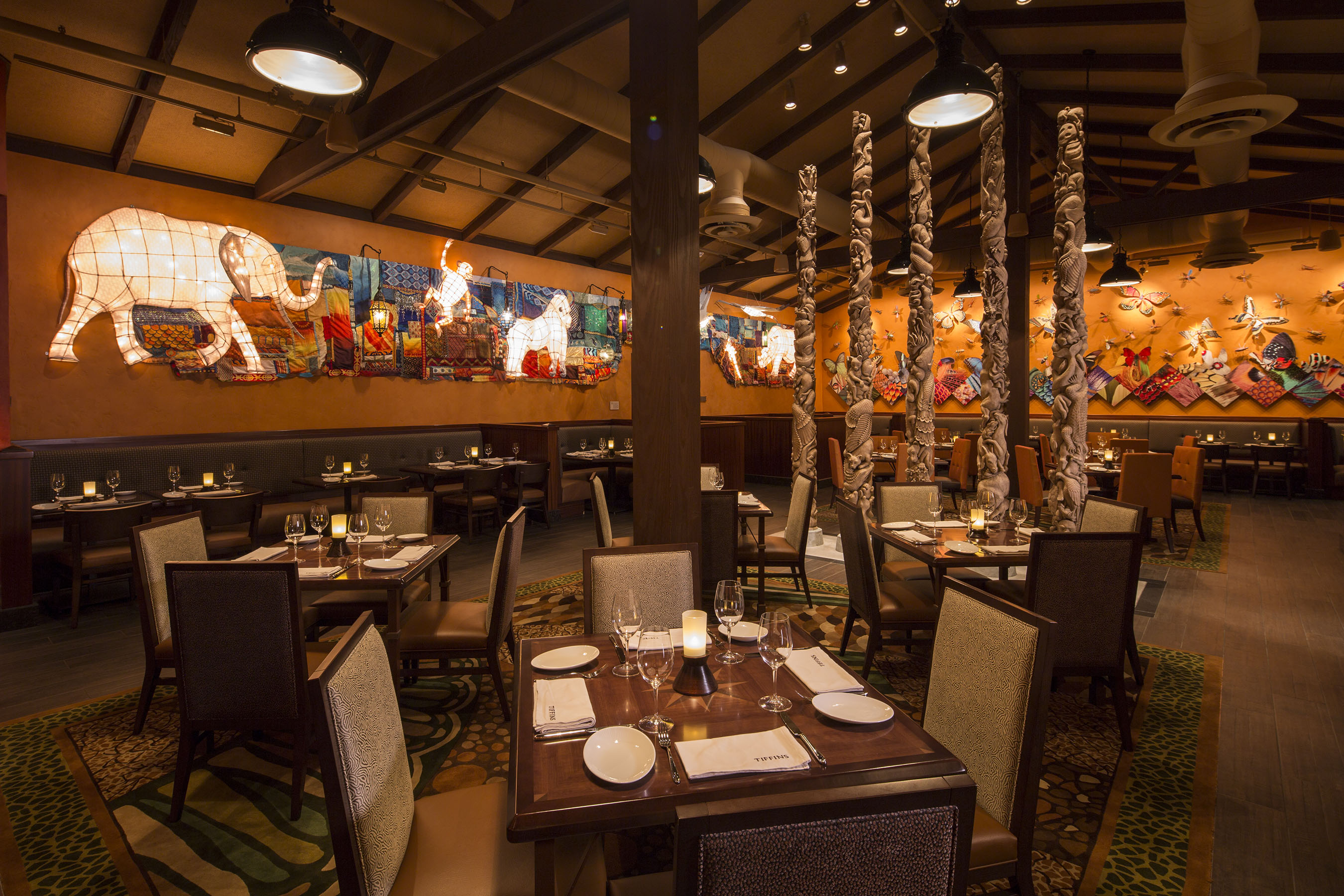
Tiffins is a new restaurant
within the Animal Kingdom Theme Park and has an
adventure theme fit for “seafarers, fortune
hunters and vagabonds,” its walls hung with
African elephant art, its ceiling held up by
carved wooden totems, with an Asian bar/lounge
with rattan chairs, hanging pendants and gauzy
curtains, like the coolest Tiki Bar in Florida.
Artwork is inspired by actual notes and field
sketches of the creators of the Animal Kingdom,
and the restaurant’s name refers to the light
lunch meal served in tiered containers and
consumed by working men in India.
The food at Tiffins is a
great deal more sophisticated than that,
however, all of it brilliantly colorful and
beautifully presented. (Nothing leaves Disney’s
development kitchen called the Flavor Lab
without every detail being worked out hundreds
of times.) I enjoyed an array of dishes from the
international menu that began with a Peruvian
dish called called causa made
with mashed blue potatoes, Aji-spiked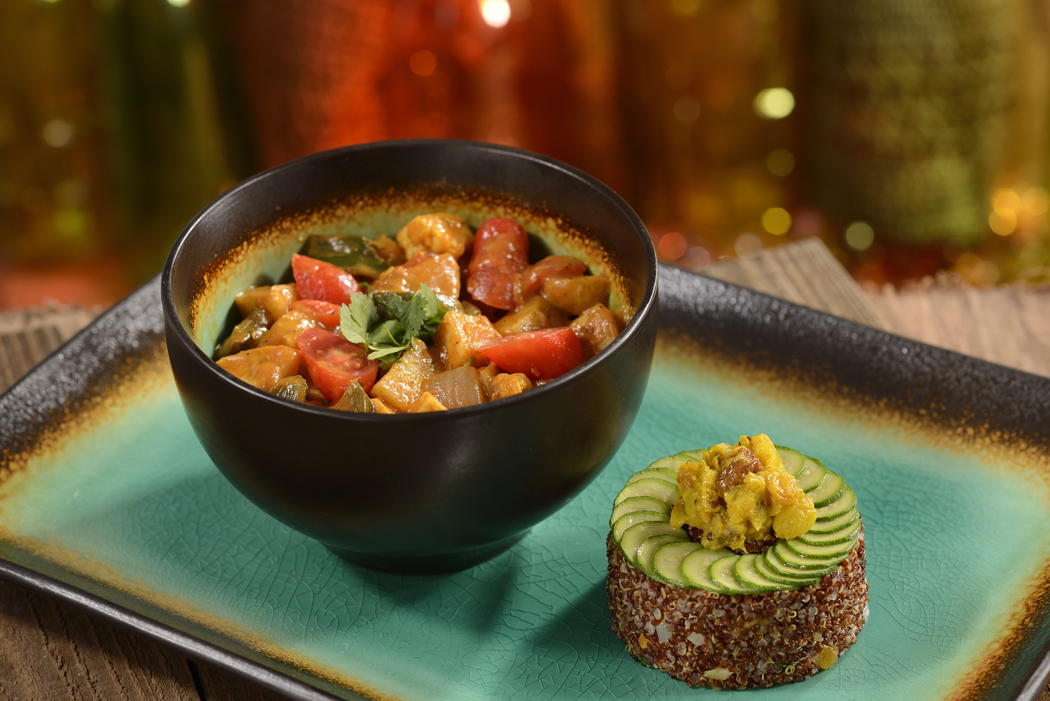 vinaigrette, lime mayonnaise, cilantro and quail
egg ($15); Hokkaido scallops came with a green
garlic panisse, peas and smoked bacon ($38),
while tender marinated octopus was grilled and
complemented by salsify, saffron aïoli and a
lemon-caper olive oil ($16).
vinaigrette, lime mayonnaise, cilantro and quail
egg ($15); Hokkaido scallops came with a green
garlic panisse, peas and smoked bacon ($38),
while tender marinated octopus was grilled and
complemented by salsify, saffron aïoli and a
lemon-caper olive oil ($16).
These are the kinds of dishes
that might be found in modern restaurants both
in and out of Asia, and there is an admirable
consistency of Far Eastern techniques used in
dishes like whole fried yellowtail with
fermented black bean sauce and peanuts ($43) or
a platter of wagyu beef strip loin and braised
short rib with rainbow carrots, Peruvian
potatoes and chimichurri hot sauce ($53). Lamb
loin is infused with a coffee butter and comes
with the South African sausage called boerwors,
soubise onion sauce, chakalaka tomato-and-bean
sauce, and leek ash ($41). And they are not
holding back on the spicing, staying true to the
food cultures presented here.
Desserts
are a bit less global but no less delectable,
like the chocolate ganache with caramelized
bananas and cocoa nib tuile ($12) or the passion
fruit tapioca cream with chocolate crumble and
citrus fruits ($9).
By John Mariani
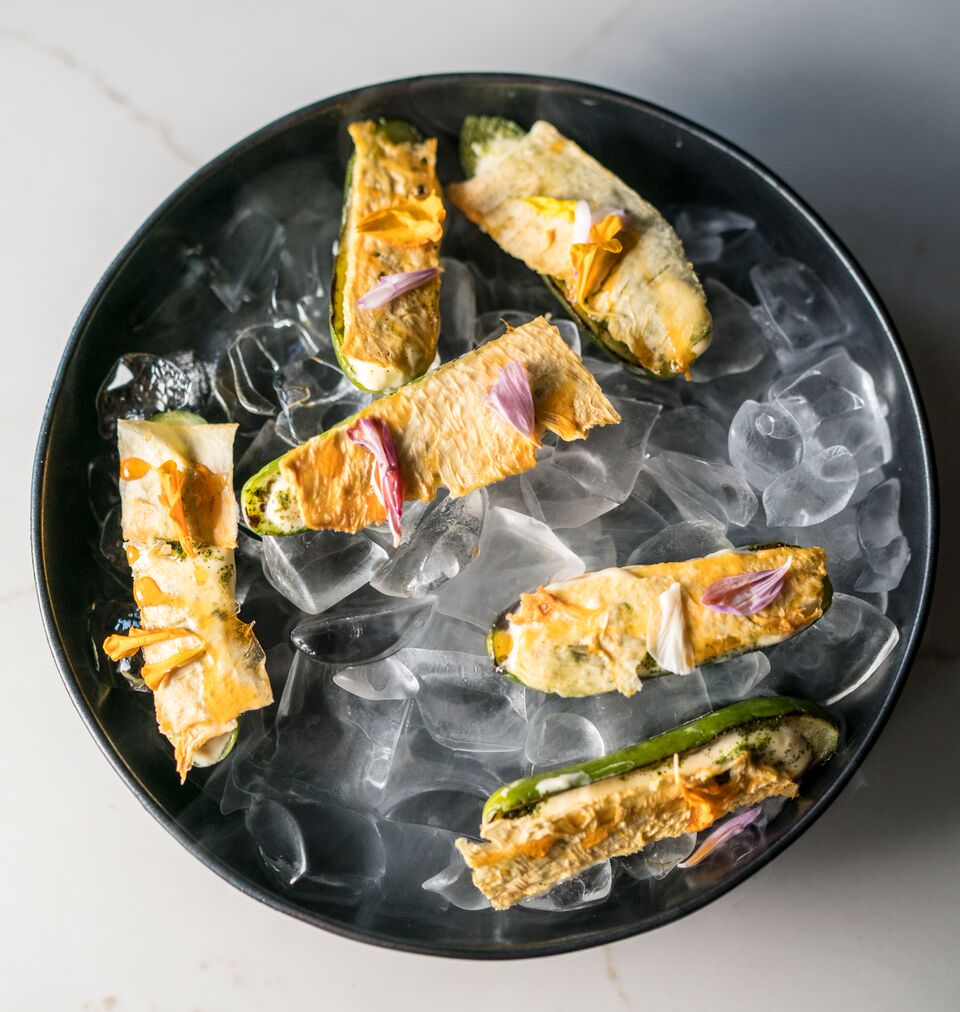 RAHI
RAHI 60 Greenwich Avenue (near Perry Street)
Faithful
readers of this newsletter’s New York Corner
may have noticed that I’ve covered a slew of
Indian restaurants lately, which has given me
a good idea of just how the sub-continent’s
diverse cuisine is now represented in NYC,
which is a far cry from the dumbed-down
100-item curry houses of the past.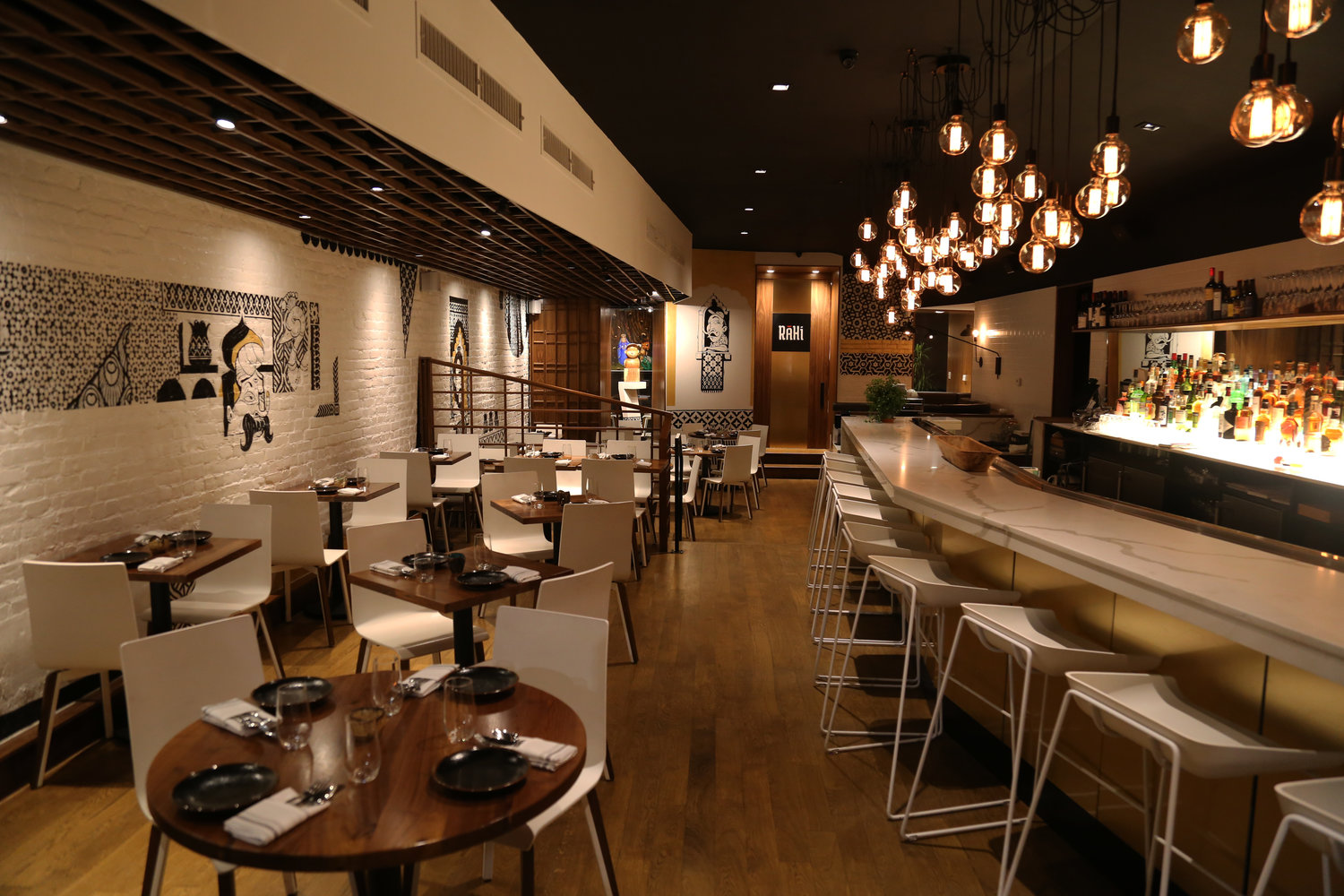
For one thing, the owners and
chefs of these new Indian restaurants are
focusing more on their own regions, from Goa to
Mumbai, from Benares to Jaipur, with far less
reliance on the entrenched Mogul dishes derived
from the days of the Raj that have so long
dominated. Rahi in Greenwich Village, opened in
May, does not only feature a wider array of
Indian cuisine but, thanks to Chef Chintan
Pandya, from Mumbai, is doing so in a colorfully
modern, individualistic way quite a bit ahead of
the pack. The menu is divided into sections
called “In-a-NY-Minute,” which are snack-like
appetizers, and “Leisurely” main courses.
There is a five-course
tasting menu at $68 and seven courses at $88,
with wine pairing available. I’d recommend those
routes.There really is nothing on the menu I’ve
run across before except for Rahi's riffs on
Indian themes like paneer tikka kebabs with
mango, ginger, mint and goat’s cheese ($14), and
eggplant bharta, a Punjabi dish of mashed
eggplant smoked with charcoal, with onion,
cumin, coriander and puffy naan bread ($17).
Otherwise every dish arrives in a beautiful
presentation on individual plate
surfaces—ceramic, wood, 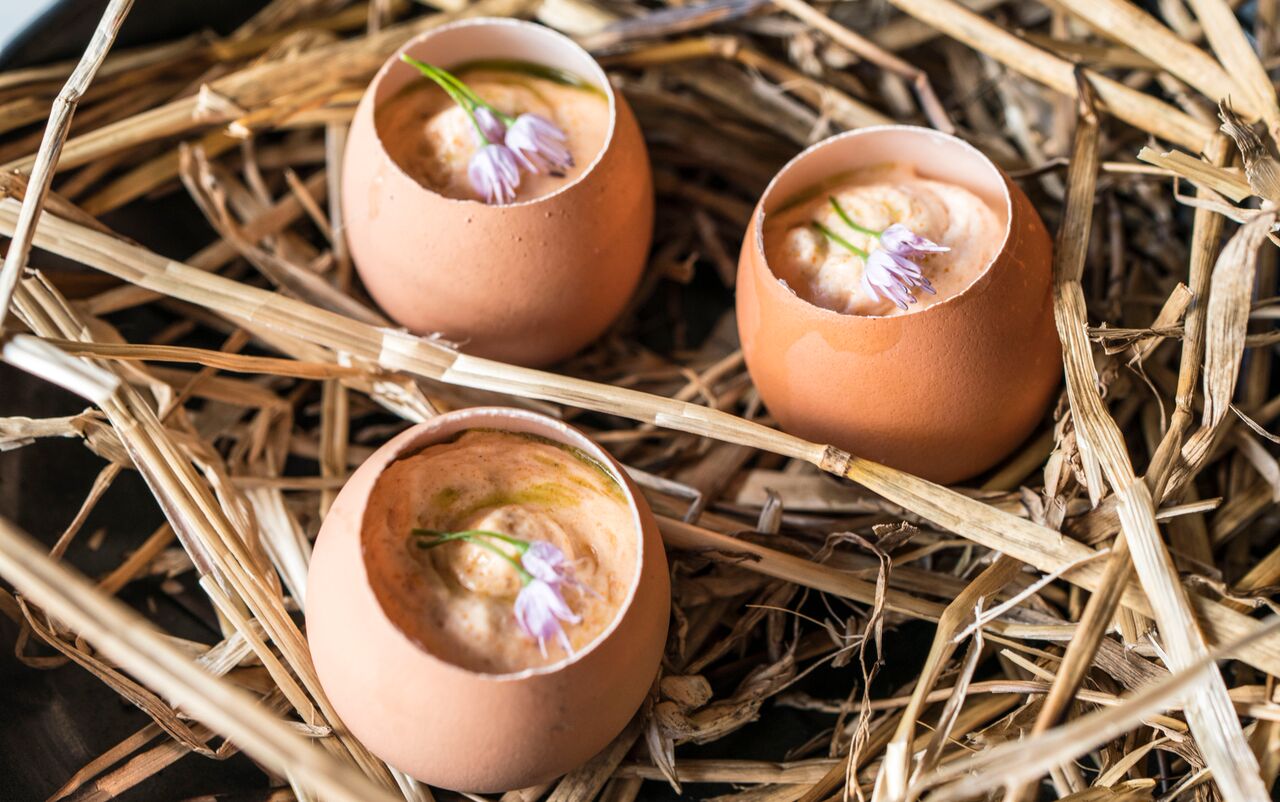 marble. As the dish
arrives, you may puzzle as to which one it is
that you ordered. There are no copper pots of
brown stews here, no sizzling platters of orange
tandoori chicken.
marble. As the dish
arrives, you may puzzle as to which one it is
that you ordered. There are no copper pots of
brown stews here, no sizzling platters of orange
tandoori chicken.
Instead
you’ll find a Madrasi egg roast ($14) made of a
yolk set on a lush onion-tomato mousse, spiked
with chili oil and sweetened with maple. “Kheera on
the rocks” consists of grilled cucumber and
yogurt with dehydrated pineapple set atop ice
cubes ($14)—cute idea but not really very
flavorful. Chettinad octopus ($21), a Tamil
dish, also gets mousse-ed, this time with
coconut, kataifi
crisps and lemon zest. Tulsi chicken is fragrant
with basil, hot from Thai chili and spiced with
pink peppercorns and sweet orange marmalade
($15). Chorizo seekh ($16) is ground lamb served
with pepper jack cheese and berry compote, which
could very easily be a dish you’d get in
Seattle, and I was intrigued by what a Dalhousie
Shepherd’s Pie ($25) would be. Named after a
British Governor in the region of Himachal
Pradesh, it had the look of that  British
pub staple, only a lot prettier, with
cumin-scented mashed potato and roulette cheese
to enrich the seasoned ground lamb beneath.
Fragrant chicken steamed in a banana leaf ($25)
with fragrant basmati rice and a coconut curry
is derived from Kerala on the Malabar
Coast. Juniper berry lamb chops ($28) were
all right, but needed the enlivening of the
chipotle peppers, jaggery sugar, ginger and
salad. The closest thing to a traditional curry
was duck kozhi
($32), a Kerala-style dish, with vermicelli
noodles and rosy slices of duck breast in
coconut milk scented with cardamom.
British
pub staple, only a lot prettier, with
cumin-scented mashed potato and roulette cheese
to enrich the seasoned ground lamb beneath.
Fragrant chicken steamed in a banana leaf ($25)
with fragrant basmati rice and a coconut curry
is derived from Kerala on the Malabar
Coast. Juniper berry lamb chops ($28) were
all right, but needed the enlivening of the
chipotle peppers, jaggery sugar, ginger and
salad. The closest thing to a traditional curry
was duck kozhi
($32), a Kerala-style dish, with vermicelli
noodles and rosy slices of duck breast in
coconut milk scented with cardamom.
Desserts
are all done with the same modern flair, not
least the lovely cubes of scented cheesecake set
with fresh flowers on a vermillion plate (right).
The
façade of Rahi is a pleasing white storefront
that could house any kind of West Village
restaurant or boutique, but inside it looks
little like any other Indian restaurant in the
neighborhood. The walls are white brick, flanked
by a white marble bar, and beginning at the
entrance there is a series of dreamy photos that
evoke the name Rahi—traveler—which owner Roni
Mazumdar has chosen to distinguish his vision
and Chef Pandya’s cuisine. That they have
succeeded shows how receptive New Yorkers and
Americans have become to these new styles of
Indian cooking from a country that is one-third
the size of the U.S. but with three times the
population.
Rahi is
open nightly for dinner, Sat. and Sun. for
Brunch
❖❖❖
CHABLIS
A Bit of Enlightenment
By Geoff Kalish
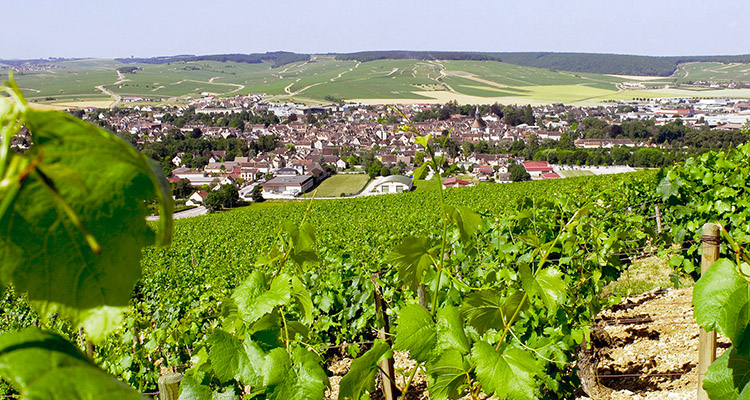
The Town of Chablis
Photo: Alain Doire, Borgogne Tourism
Since
my first encounter with the term “Chablis”—in the
early 1970s in New Orleans, where all dry white
wine, usually in jugs, was referred to as
“chabliss”—I’ve enjoyed the “real”
stuff with a variety of fare, especially shellfish
and grilled chicken breast.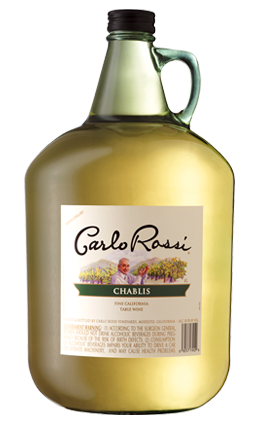 Like
most U.S. consumers, however, while I knew that
the wine by law must be made of the Chardonnay
grape from the demarcated vineyards surrounding
the town of Chablis, my knowledge of the
differences between Petit Chablis, Chablis,
Prémiere Cru and Grand Cru Chablis was minimal.
So, a recent visit to the facilities of William
Fèvre and Domaine Laroche in the northern Burgundy
town of Chablis was especially enlightening.
Like
most U.S. consumers, however, while I knew that
the wine by law must be made of the Chardonnay
grape from the demarcated vineyards surrounding
the town of Chablis, my knowledge of the
differences between Petit Chablis, Chablis,
Prémiere Cru and Grand Cru Chablis was minimal.
So, a recent visit to the facilities of William
Fèvre and Domaine Laroche in the northern Burgundy
town of Chablis was especially enlightening.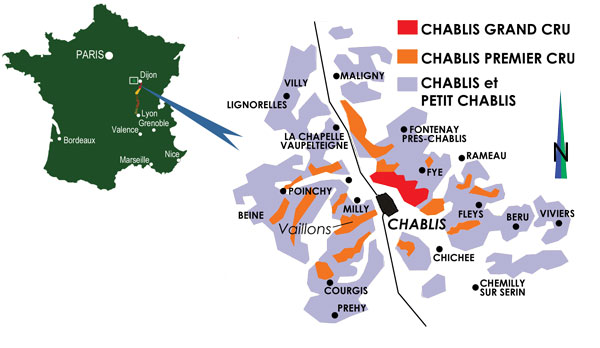
Maps at both vintners showing the
position of the various vineyards were particularly
helpful, as were examples of the different types of
soil found in the vineyards. For example, the soil
of the vineyards from which Petit Chablis is
produced contains mainly limestone, while that of
Chablis and the Prémiere and Grand crus contains a
type of limestone dating from the Jurassic age that
incorporates fossilized shells of mollusks and
crustaceans, providing
the wine made from vines grown in this soil with a
particular richness and the characteristic “flinty”
taste.
In addition, while all the
vineyards of Chablis face south, Grand Cru sites
face southwest,
allowing for the longest daytime hours of sun
for maximum ripening. Also, because of its quite
northern location and differences in year-to-year
climate, vintages of Chablis can vary widely, with
very warm years producing wines without much acidity
and just the opposite in years that are too cool.
And, while most Chablis is now fermented in
temperature-controlled stainless steel tanks,
varying degrees of barrel fermentation can markedly
alter the aesthetics of the wine—not always for the
better.
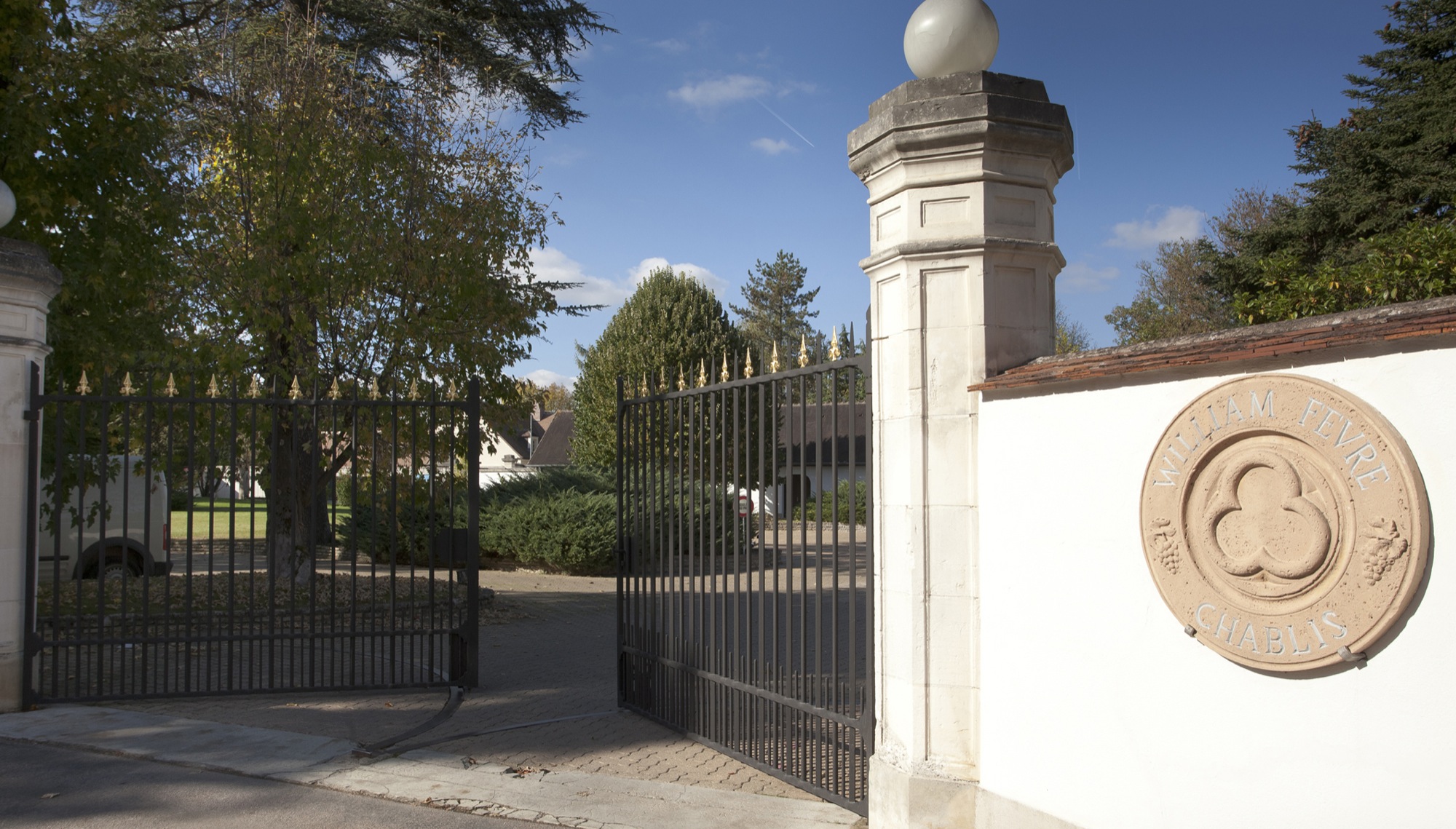 Founded in
1959, Domaine William Fèvre (left) owns the
largest amount of Grand Cru property (38 acres) of
any producer, in addition to 158 acres of other
Chablis vineyards; in general the domaine produces
about 80,000 cases of wine annually. In my tasting
the Grand Crus showed a richness and depth of flavor
far greater than the Petit, Domaine Chablis or
Prémiere Crus, with the exception of the wine from
the Vaulorent vineyard, which abuts the Grand Crus
and, to my taste, combined the best features of the
Prémiere and Grand Crus.
Founded in
1959, Domaine William Fèvre (left) owns the
largest amount of Grand Cru property (38 acres) of
any producer, in addition to 158 acres of other
Chablis vineyards; in general the domaine produces
about 80,000 cases of wine annually. In my tasting
the Grand Crus showed a richness and depth of flavor
far greater than the Petit, Domaine Chablis or
Prémiere Crus, with the exception of the wine from
the Vaulorent vineyard, which abuts the Grand Crus
and, to my taste, combined the best features of the
Prémiere and Grand Crus.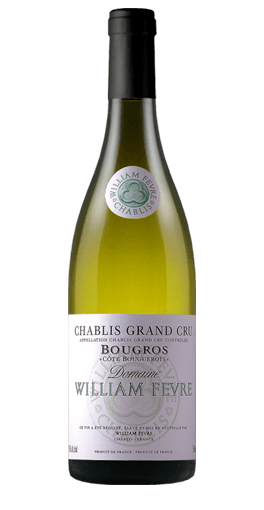
For example,
while both were totally fermented in stainless
steel, the 2015 Petite Chablis ($18) showed a
bouquet and very light taste of lemons and apples
with a short crisp somewhat acidic finish, as
compared with the 2013 Domaine Chablis ($22), which
showed a similar bouquet and taste but a fuller
finish. On the other hand, the 2015 Prémiere Crus
from the Montmains ($44) and Vaillons ($41)
vineyards, which had some degree of barrel
fermentation, showed notes of apricots and pears and
less of the lemony bouquet and taste of the Domaine
Chablis and a vibrant, yet less acidic, finish.
I found the two wines sampled
from Grand Cru vineyards Vaudesir ($63) and Bougros
($80) showing a more fragrant bouquet, but lighter
in body than the Prémiere Crus sampled. And,
surprisingly, I found the 2013 Prémiere Cru from
Vaulorent ($55), which was 50% fermented in barrels,
then aged for 10 months to combine the best features
of the Premiere and Grand Crus, showing a very
fragrant bouquet and taste of lemons, apples and
pears with notes of apricots and a smooth finish
with hints of honey. While it would be easy to
attribute this difference to the 50% barrel
fermentation,
examples of Prémiere Crus from this vineyard
from other producers sampled during our visit showed
similar aesthetics, which in my opinion makes
Chablis from Vaulorent a worthy bargain compared
with those of Grand Cru vineyards.
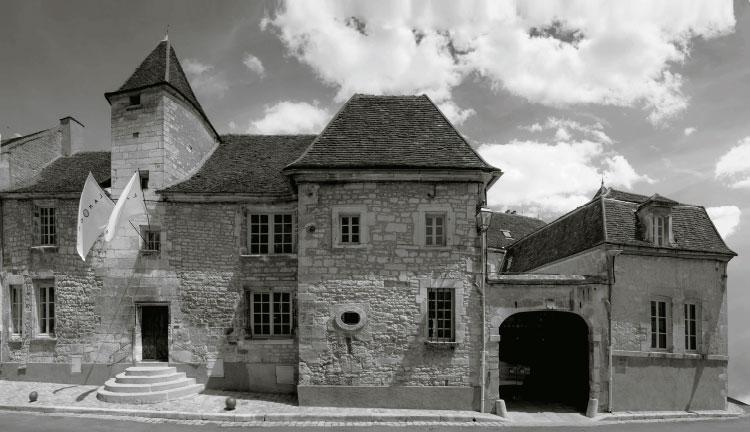 I found very
similar distinctions in the range of Chablis at Domaine
Laroche (left)
as those at William Fèvre. For example, the 2015
Domaine Laroche Petit Chablis ($18) showed a light
bouquet of apples and lemons with a short, crisp
finish as compared with the 2015 Chablis ($19),
which in addition to a bouquet and flavor of apples
and lemons had notes of dried apricots and earthy
spice, with a crisp but rather long finish. And the
2014 Domaine Laroche Premiere Cru Les
Fourchaumes Vielles Vignes ($95), from an
area just a bit north of Vaulorent, had a
bouquet and taste of apples, apricots and notes of
figs with a crisp, memorable finish, outshining the
two 2014
vintage Domaine Laroche Grand Crus that I sampled.
I found very
similar distinctions in the range of Chablis at Domaine
Laroche (left)
as those at William Fèvre. For example, the 2015
Domaine Laroche Petit Chablis ($18) showed a light
bouquet of apples and lemons with a short, crisp
finish as compared with the 2015 Chablis ($19),
which in addition to a bouquet and flavor of apples
and lemons had notes of dried apricots and earthy
spice, with a crisp but rather long finish. And the
2014 Domaine Laroche Premiere Cru Les
Fourchaumes Vielles Vignes ($95), from an
area just a bit north of Vaulorent, had a
bouquet and taste of apples, apricots and notes of
figs with a crisp, memorable finish, outshining the
two 2014
vintage Domaine Laroche Grand Crus that I sampled.
Of note, I found
that independent of whether the wine was simple
Chablis, or Prémiere or Grand Cru, they all mated
well with not only simple shellfish and chicken but
a range of fare from delicate daurade to dishes of
shrimp in bold sauces and even pork belly and
braised and barbecued duck. And finally, except
Petit Chablis, wines with a few years of bottle age
seemed to have a more fragrant bouquet and depth of
flavor than younger wines.
 CALLING
ALL CARS. . . CALLING ALL CARS . . . BE ON THE
LOOK-OUT FOR ROLLING BBQ PIT. . . SUSPECTS MAY BE
ARMED WITH KITCHEN TONGS
CALLING
ALL CARS. . . CALLING ALL CARS . . . BE ON THE
LOOK-OUT FOR ROLLING BBQ PIT. . . SUSPECTS MAY BE
ARMED WITH KITCHEN TONGS
Police in Albuquerque, N.M., are hunting
for a 1,700-pound barbecue pit stolen, from Pepper's Ole
Fashion BBQ. Daniel
Morgan, proprietor, said the pit was in use at the time
cooking a 200-pound brisket: “What on God’s earth
do you think they would want with it? It’s
three-quarter-inch steel, diamond-cut chrome. It’s got
burners on it that allows you to boil, sauté and fry
fish. Of course, it’s on a trailer.”
BLOCK THAT
ADVERB!
“Restaurant Andrew Fairlie is an
opulent dining room 
with a reassuringly expensive menu.”—Restaurant Magazine
(July 2017)
Any of John Mariani's books below may be ordered from amazon.com.
 The
Hound in Heaven (21st Century Lion Books)
is a novella, and for anyone who loves dogs,
Christmas, romance, inspiration, even the supernatural, I
hope you'll find this to be a treasured favorite.
The story concerns how, after a New England teacher,
his wife and their two daughters adopt a stray puppy found
in their barn in northern Maine, their lives seem full of
promise. But when tragedy strikes, their wonderful dog
Lazarus and the spirit of Christmas are the only things
that may bring his master back from the edge of
despair.
The
Hound in Heaven (21st Century Lion Books)
is a novella, and for anyone who loves dogs,
Christmas, romance, inspiration, even the supernatural, I
hope you'll find this to be a treasured favorite.
The story concerns how, after a New England teacher,
his wife and their two daughters adopt a stray puppy found
in their barn in northern Maine, their lives seem full of
promise. But when tragedy strikes, their wonderful dog
Lazarus and the spirit of Christmas are the only things
that may bring his master back from the edge of
despair. WATCH THE VIDEO!
“What a huge surprise turn this story took! I was completely stunned! I truly enjoyed this book and its message.” – Actress Ali MacGraw
“He had me at Page One. The amount of heart, human insight, soul searching, and deft literary strength that John Mariani pours into this airtight novella is vertigo-inducing. Perhaps ‘wow’ would be the best comment.” – James Dalessandro, author of Bohemian Heart and 1906.
“John Mariani’s Hound in Heaven starts with a well-painted portrayal of an American family, along with the requisite dog. A surprise event flips the action of the novel and captures us for a voyage leading to a hopeful and heart-warming message. A page turning, one sitting read, it’s the perfect antidote for the winter and promotion of holiday celebration.” – Ann Pearlman, author of The Christmas Cookie Club and A Gift for my Sister.
“John Mariani’s concise, achingly beautiful novella pulls a literary rabbit out of a hat – a mash-up of the cosmic and the intimate, the tragic and the heart-warming – a Christmas tale for all ages, and all faiths. Read it to your children, read it to yourself… but read it. Early and often. Highly recommended.” – Jay Bonansinga, New York Times bestselling author of Pinkerton’s War, The Sinking of The Eastland, and The Walking Dead: The Road To Woodbury.
“Amazing things happen when you open your heart to an animal. The Hound in Heaven delivers a powerful story of healing that is forged in the spiritual relationship between a man and his best friend. The book brings a message of hope that can enrich our images of family, love, and loss.” – Dr. Barbara Royal, author of The Royal Treatment.
 |
The Encyclopedia of American Food and Drink by John F. Mariani (Bloomsbury USA, $35) Modesty forbids me to praise my own new book, but let me proudly say that it is an extensive revision of the 4th edition that appeared more than a decade ago, before locavores, molecular cuisine, modernist cuisine, the Food Network and so much more, now included. Word origins have been completely updated, as have per capita consumption and production stats. Most important, for the first time since publication in the 1980s, the book includes more than 100 biographies of Americans who have changed the way we cook, eat and drink -- from Fannie Farmer and Julia Child to Robert Mondavi and Thomas Keller. "This book is amazing! It has entries for everything from `abalone' to `zwieback,' plus more than 500 recipes for classic American dishes and drinks."--Devra First, The Boston Globe. "Much needed in any kitchen library."--Bon Appetit. |
"Eating Italian will never be the same after reading John Mariani's entertaining and savory gastronomical history of the cuisine of Italy and how it won over appetites worldwide. . . . This book is such a tasteful narrative that it will literally make you hungry for Italian food and arouse your appetite for gastronomical history."--Don Oldenburg, USA Today. "Italian
restaurants--some good, some glitzy--far
outnumber their French rivals. Many of
these establishments are zestfully described
in How Italian Food Conquered the World, an
entertaining and fact-filled chronicle by
food-and-wine correspondent John F.
Mariani."--Aram Bakshian Jr., Wall Street
Journal.
"Equal parts
history, sociology, gastronomy, and just
plain fun, How Italian Food Conquered the
World tells the captivating and delicious
story of the (let's face it) everybody's
favorite cuisine with clarity, verve and
more than one surprise."--Colman Andrews,
editorial director of The Daily
Meal.com. "A fantastic and fascinating
read, covering everything from the influence
of Venice's spice trade to the impact of
Italian immigrants in America and the
evolution of alta cucina. This book will
serve as a terrific resource to anyone
interested in the real story of Italian
food."--Mary Ann Esposito, host of PBS-TV's
Ciao
Italia. "John Mariani has written the
definitive history of how Italians won their
way into our hearts, minds, and
stomachs. It's a story of pleasure over
pomp and taste over technique."--Danny Meyer,
owner of NYC restaurants Union Square
Cafe, The Modern, and Maialino.
|
 |
 |
 |
 |
 |
 |
 |
 |
 Everett Potter's Travel Report:
Everett Potter's Travel Report: 
 Eating Las Vegas
JOHN CURTAS has been covering the Las Vegas
food and restaurant scene since 1995. He is
the co-author of EATING LAS VEGAS – The 50
Essential Restaurants (as well as
the author of the Eating Las Vegas web site: www.eatinglasvegas.
He can also be seen every Friday morning as
the “resident foodie” for Wake Up With the
Wagners on KSNV TV (NBC) Channel 3 in
Las Vegas.
Eating Las Vegas
JOHN CURTAS has been covering the Las Vegas
food and restaurant scene since 1995. He is
the co-author of EATING LAS VEGAS – The 50
Essential Restaurants (as well as
the author of the Eating Las Vegas web site: www.eatinglasvegas.
He can also be seen every Friday morning as
the “resident foodie” for Wake Up With the
Wagners on KSNV TV (NBC) Channel 3 in
Las Vegas.

MARIANI'S VIRTUAL GOURMET
NEWSLETTER is published weekly. Editor/Publisher: John
Mariani.
Editor: Walter Bagley. Contributing Writers: Christopher Mariani,
Robert Mariani, Misha Mariani, John A. Curtas, Geoff Kalish, Mort
Hochstein, and
Brian Freedman. Contributing Photographer: Galina
Dargery. Technical Advisor: Gerry McLoughlin.
To un-subscribe from this newsletter,click here.
© copyright John Mariani 2017

